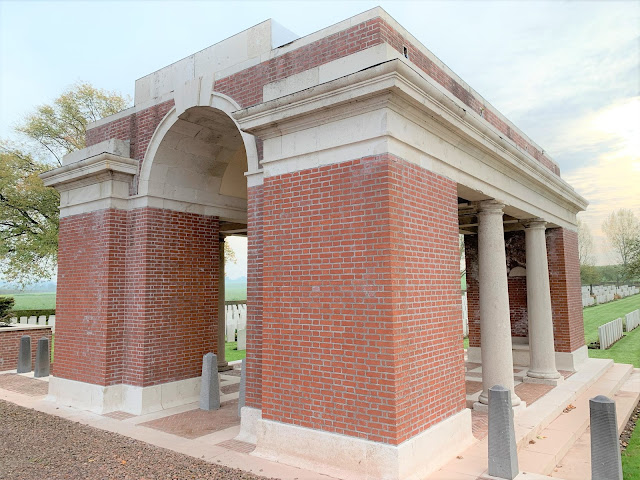Our tour of the Great War continues.
From Vimy Ridge, we traveled south toward the town of Albert. Along the way, we stopped at a British military cemetery. We could have stopped at many other military cemeteries--other British cemeteries, plus French, German, Canadian, South African, Australia and communal burial grounds. There are more than 200 in the region.

After visiting the cemetery, we headed to the nearby town of Albert. During the Great War, Albert was near or at the front for a long period. So, it suffered a lot of destruction. Today, none of the destruction is evident. However, Albert commemorates its history with a museum and with activities for visitors, such as battlefield and cemetery visits. Also, we spotted several pubs for British and other visitors. Many Commonwealth soldiers fought and died in the region near Albert.
In the Great War, Albert was shelled during the fighting. The basilica in Albert, Notre Dame de Brebières was damaged but not destroyed. Below are photos showing the basilica during the war and following its eventual restoration.

In the left photo above, the statue atop the basilica was leaning but had not yet fallen. The people of Albert believed it was a sign.
Today, the basilica is beautifully restored.
While admiring the basilica, we spotted some lovely seasonal flowers.
During our stroll through Albert, we discovered the mural below commemorating the Great War. The restored statue appears in the background.
Albert is home to a very good museum dedicated to the soldiers of the Great War, the Somme 1916 Museum. In front of the entrance to the museum, we found a statue of a soldier and some artillery pieces.
 |
| Mike stands next to Tommy |
The museum, opened in 1992, is located 30 feet underground in a tunnel first dug in the 1200's. (The tunnel served as an air raid shelter during WWII.) Today, the tunnel is filled with many artifacts and displays illustrating the lives of soldiers during the Battle of the Somme in 1916.
The museum features several realistic scenes of soldiers in trenches and tunnels. Below, German soldiers and artifacts are displayed.

The museum has thousands of artifacts of all types--uniforms, guns and so on. During our visit, we spotted a display of Red Cross artifacts (pictured below). Mike and Greg were reminded that their maternal grandfather, Francis Morse, served as U.S. Army ambulance driver during the Great War.
When fighting lulled, soldiers in the trenches battled fatigue and boredom. One way to combat boredom was creating trench art (pictured below).
We enjoyed learning more about the war at the museum.
We ended our tour of the Great War in Albert and then returned to Paris. Reflecting on our tour, we concluded that we are fortunate to live when and where we do.















No comments:
Post a Comment